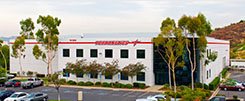
Billet aluminum wheels are much stronger than cast aluminum wheels for a couple of reasons. The first is that there are no porosity issues to have to worry about. This means that there is no chance of minute air bubbles in the metal. Turbonetics uses a special process called HIP’ing. Hot Isostatic Processing that virtually eliminates porosity in its cast wheels. Turbonetics provides a forged billet compressor wheel which is even stronger than standard billet wheels because the grains of metal have been moved in such a way as to align in a specific direction.
Because Turbonetics uses Forged Billet to machine the compressor wheel on a 5-Axis mill, the nose and hub of the compressor wheel can be made significantly smaller to allow for a greater blade diameter for a given inducer size. The nose is where the compressor nut gets fastened down and the hub is the area around the bore of the wheel that the impeller blades are attached to. A cast wheel has to have a certain size nose and hub to allow the wheel to be cast number one and secondly it has to be able to be pulled from the mold itself. So simply stated a 61mm Forged Billet turbo will flow more air and have the opportunity to make more power than the same 61mm turbo with a cast compressor wheel.
The specific metal material used in Turbonetics forged wheels also gives the wheel tremendous blade strength and lowers the chance of the blades straightening at high speeds (ie. high boost pressures). When the boost pressure is raised many things occur including increased friction with the air and increasing temperatures, the pressure on the wheel and the great centrifugal force the blades are under spinning at high speeds. These three factors can cause the blades to contact the compressor housing causing serious damage to the turbocharger and could possibly lead to immediate destruction or greatly decrease the life span of the turbocharger.
With forged billet impellers the blades of the wheel can be machined thinner and stronger. This allows the wheel to have a greater efficiency range due to less blade thickness in contact with the air. This also translates into less blade thickness and lower hub area that results in a greater area between the blades to pressurize more air and build greater boost pressure. The more efficient a wheel is, the lower the intake temps and the cooler the air going to the engine hence more horsepower.









